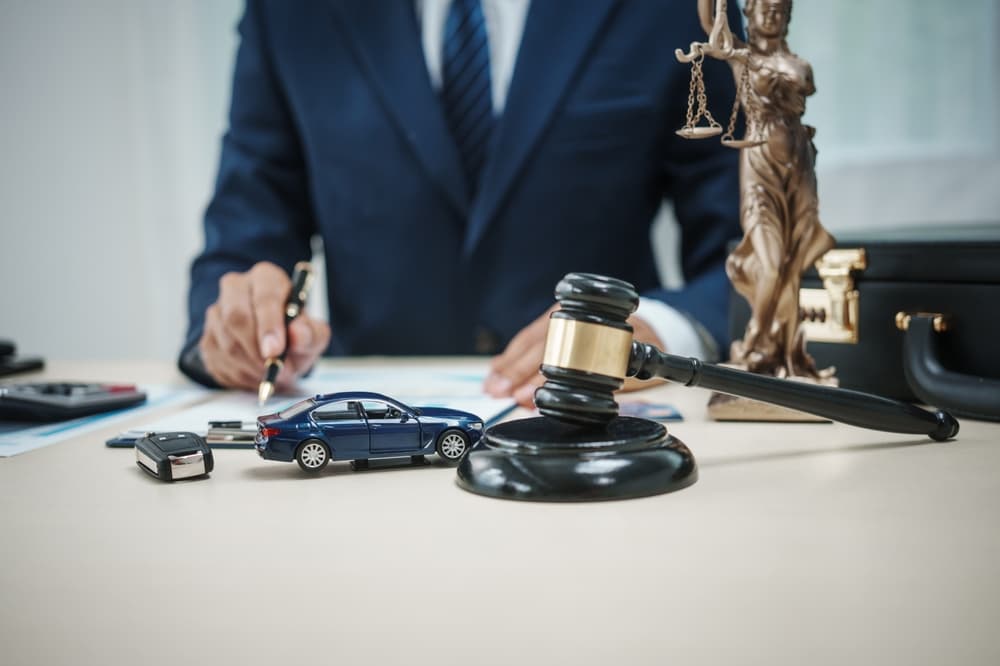
Understanding the Deadliest Car Accidents
Head-on car collisions shatter thousands of lives in the U.S. every year. These devastating crashes account for a disproportionate number of deaths and catastrophic injuries on our roads, leaving families torn apart and survivors facing a long, challenging road to recovery.
If you or a loved one were injured in a head-on car collision because of an errant or reckless driver, you're likely going through a dark time. Pain, emotional trauma, grief, anxiety, confusion, and uncertainty about what the future holds are all experiences survivors of head collisions and their loved ones face.
An experienced car accident lawyer can provide the answers you seek and the help you need after a head-on car accident. An experienced car accident attorney at Gray Ritter Graham, decades of compassionate, client-centered service and proven results are the bedrock of our success.
The Anatomy of Head-On Car Collisions
Head-on car collisions occur when the front ends of two vehicles crash into each other, generating violent forces even at relatively low speeds. According to the Insurance Institute for Highway Safety (IIHS), head-on collisions account for only 2% of crashes but result in 10% of all motor vehicle fatalities.
The physics of head-on collisions make them particularly deadly. When two vehicles traveling in opposite directions collide, the force of impact is effectively doubled compared to hitting a stationary object. This tremendous force is then transferred to the occupants of both vehicles, often resulting in catastrophic injuries.
Factors Contributing to Head-On Car Crashes
 While 2% of all U.S. car crashes may not seem like a lot, that amounts to tens of thousands of serious head-on car collisions annually. Understanding the causes of all these crashes sheds some light on liability issues, which are fundamental to any car accident case. These causes include:
While 2% of all U.S. car crashes may not seem like a lot, that amounts to tens of thousands of serious head-on car collisions annually. Understanding the causes of all these crashes sheds some light on liability issues, which are fundamental to any car accident case. These causes include:
Distracted Driving
Distracted driving has become a leading cause of accidents in our increasingly connected world. Using smartphones diverts attention from the road and can cause a driver to drift into oncoming traffic. Eating, adjusting the radio, or any other distracting activity can have an equally dangerous effect.
Impaired Driving
Alcohol, drugs, or fatigue severely impair a driver's judgment and reaction time, significantly increasing the risk of head-on collisions. Impaired drivers are more likely to drift across centerlines or drive the wrong way, leading to devastating frontal impacts with oncoming traffic.
According to the NHTSA, 37 people in the U.S. die in drunk-driving crashes every day. A substantial portion of these fatalities result from head-on collisions, as impaired drivers often fail to recognize or correct their vehicle's path until it's too late. The NTSB has found that about 22% of wrong-way crashes, which frequently result in head-on collisions, involved intoxicated drivers.
Speeding
Excessive speeds make it harder to control a vehicle and avoid potential hazards. The higher the speed, the less time a driver has to react to unexpected situations, increasing the risk of crossing into opposing lanes.
Improper passing:
Attempting to overtake vehicles without sufficient visibility or space puts drivers at risk of colliding with oncoming traffic. This is particularly dangerous on two-lane roads where there's no physical barrier between opposing traffic flows.
Wrong-way driving
Confused or impaired drivers may accidentally travel in the wrong direction on roads or highway ramps. While relatively rare, these incidents often result in high-speed head-on collisions with devastating consequences.
Poor weather conditions
While weather rarely causes crashes, drivers' handling of their vehicles in adverse conditions can lead to losing control and crossing into opposing lanes.
Vehicle defects and poor maintenance
Faulty brakes, tire blowouts, steering system failures, and other auto defects can cause drivers to lose control and veer into oncoming traffic. While less common than human error, mechanical issues can be just as deadly.
Road Design and Maintenance
Although rare, poorly designed or maintained roads can contribute to head-on collisions. Lack of proper signage, inadequate lighting, missing guardrails, or poorly marked lanes can increase the risk of these accidents.
Where Head-On Car Collisions Commonly Occur
 While head-on car accidents can happen anywhere, certain road types and conditions increase the risk:
While head-on car accidents can happen anywhere, certain road types and conditions increase the risk:
Rural roads and highways
The National Highway Traffic Safety Administration (NHTSA) reports that about 75% of head-on collisions in the U.S. occur on rural roads. These areas often lack median barriers and have intermittent passing zones, increasing the potential for cross-centerline crashes.
Two-lane roads
Roads without physical separation between opposing traffic lanes are particularly dangerous, especially when combined with curves, hills, or limited visibility. The temptation to pass slower vehicles on these roads can lead to catastrophic miscalculations.
Highway entrance and exit ramps
Wrong-way drivers on these ramps often cause high-speed head-on collisions. The Federal Highway Administration (FHWA) estimates that wrong-way driving crashes on highways claim 300 to 400 lives each year in the United States.
Intersections
Drivers running red lights or making improper turns can cause head-on collisions with oncoming vehicles. At intersections, a driver's failure to yield right-of-way or misjudgment of oncoming traffic speed can result in direct, front-end impacts.
Construction zones
Altered traffic patterns and narrow lanes in work zones can increase the risk of head-on car crashes. Confused drivers may inadvertently cross into oncoming traffic, while reduced maneuvering space can make it difficult to avoid frontal impacts when faced with sudden obstacles or lane changes.
The Devastating Consequences of Head-On Collisions
The injuries resulting from head-on car accidents are often severe and life-altering. The violent nature of these crashes means that occupants are subjected to extreme forces, leading to a range of traumatic injuries:
- Traumatic Brain Injuries (TBIs): The violent impact can cause the brain to collide with the skull, leading to concussions, contusions, or more severe brain damage. Traumatic brain injuries can have serious long-term and life-disrupting symptoms. The Centers for Disease Control and Prevention (CDC) reports that motor vehicle crashes are a leading cause of TBI-related deaths.
- Spinal Cord Injuries: Damage to the spinal cord can result in partial or complete paralysis. According to the National Spinal Cord Injury Statistical Center, vehicle crashes are the leading cause of spinal cord injuries, accounting for 39.3% of cases since 2015.
- Chest and Abdominal Trauma: The force of impact can cause internal organ damage, broken ribs, and internal bleeding. These injuries can be life-threatening if not treated promptly.
- Fractures and Orthopedic Injuries: Multiple bone fractures, especially in the legs, arms, and pelvis, are common. These injuries often require extensive surgery and rehabilitation.
- Facial Injuries: Lacerations, fractures, and dental injuries often occur due to impact with the steering wheel, dashboard, or windshield. These can lead to permanent disfigurement and the need for reconstructive surgery.
- Whiplash and Neck Injuries: The sudden back-and-forth motion of the head and neck can cause severe soft tissue damage, leading to chronic pain and limited mobility.
- Burns: In cases where the collision leads to a vehicle fire, occupants may suffer severe burns, leading to long-term physical and emotional trauma.
- Psychological Trauma: Survivors may experience post-traumatic stress disorder (PTSD), anxiety, and depression. The emotional impact of a head-on collision can be just as debilitating as the physical injuries.
These injuries often require extensive medical treatment, rehabilitation, and long-term care. The emotional and financial toll on victims and their families can be overwhelming. Many survivors face a long road to recovery, with some never fully regaining their pre-accident quality of life.
Steps to Take After a Head-On Collision
 If you've been involved in a head-on collision, taking the right steps can protect your health and legal rights:
If you've been involved in a head-on collision, taking the right steps can protect your health and legal rights:
- Seek Immediate Medical Attention: Even if you feel fine, some injuries may not be immediately apparent. Conditions like internal bleeding or brain injuries can have delayed symptoms. Prompt medical care ensures proper diagnosis and documentation of your injuries, which is crucial for both your health and any future legal claims.
- Document the Scene: If you're able, take photos of the vehicles, road conditions, and any visible injuries. Collect contact information from witnesses. This evidence can be invaluable in determining fault and supporting your claim.
- Report the Accident: File a police report to create an official record of the incident. This document can serve as crucial evidence in your case.
- Avoid Discussing Fault: Limit your communication with other drivers or insurance representatives to exchanging basic information. Avoid admitting fault or making statements that could be used against you later.
- Keep Records: Save all medical bills, repair estimates, and any documentation related to the accident. This includes records of missed work days and any other expenses incurred as a result of the crash.
- Contact an Attorney: Consult with a car accident lawyer who can protect your rights and guide you through the legal process. They can help you navigate the complexities of insurance claims and ensure you receive fair compensation.
Your Right to Compensation For Head-On Collision Injuries
If another driver's negligence caused your head-on collision, you may be entitled to compensation for various damages:
- Medical expenses
- Lost wages or income
- Reduced earning capacity
- Property damage
- Pain and suffering
- Emotional distress
- Loss of enjoyment of life
- Disability or Disfigurement
In cases of fatal accidents, family members may pursue wrongful death claims to cover funeral expenses, loss of financial support, and loss of companionship.
The value of your claim depends on various factors, including the severity of your injuries, the extent of your economic losses, and the available insurance coverage. An experienced car accident lawyer attorney can help you calculate the full extent of your damages and fight for full and fair compensation.
Comparative Negligence Laws
Many states have comparative negligence laws that can considerably affect your compensation. Under these laws, your total damages decrease by your percentage of fault in the accident. For example, if you're found to be 20% at fault, your compensation would be reduced by 20%.
Some states have modified comparative negligence rules that prevent recovery if you're found to be 50% or more at fault. These laws underscore the importance of having skilled legal representation to protect your interests and counter any unfair accusations of fault.
The Role of a Car Accident Attorney
 Head-on collisions leave more than pain and damage in their wake—they create a maze of legal and financial burdens that can quickly drain you of your time, energy, and money. A seasoned car accident attorney can’t undo all the trauma and destruction, but they can forge a path forward so you and your family and focus on healing.
Head-on collisions leave more than pain and damage in their wake—they create a maze of legal and financial burdens that can quickly drain you of your time, energy, and money. A seasoned car accident attorney can’t undo all the trauma and destruction, but they can forge a path forward so you and your family and focus on healing.
After a head-on car crash, your attorney will provide the following:
- Thoroughly investigating your case: Your attorney will conduct a comprehensive investigation of the accident, gathering evidence such as police reports, witness statements, and expert witness analyses.
- Collecting and preserving evidence: They will work to ensure that all evidence vital to your case is properly documented and preserved.
- Negotiating with Insurance Companies: Your lawyer will handle all communications with insurance companies, protecting you from tactics they might use to minimize your claim.
- Protecting the value of your claim: Your attorney knows the extent of your damages and the full value of your claim, and they will fight to secure all the compensation you deserve.
- Preparing for trial: If the at-fault party and their insurer refuse to settle your case fairly, your lawyer should be prepared to take your case to court and argue it before a judge or jury.
Most car accident attorneys work on a contingency fee basis, meaning you don't pay unless they recover compensation for you. This allows you to focus on your recovery while your legal team fights for your rights.
Moving Forward After a Head-On Collision
The road to recovery after a head-on collision can be long and difficult. However, there are some small steps you can take that will help get your life back on track and protect the value of your claim. Here are some steps to help you move forward:
- Follow your treatment plan: Following your doctor's recommendations demonstrates that you're taking your injuries seriously. Consistency in treatment can strengthen your claim by providing a clear medical record that links your injuries directly to the accident. It also prevents the insurance company from arguing that your injuries worsened due to neglect.
- Seek support: While primarily beneficial for your mental health, seeking emotional support can also bolster your claim. Professional counseling records can serve as evidence of emotional distress, potentially increasing the non-economic damages in your claim.
- Document your recovery: A recovery journal can serve as evidence of your pain and suffering. Writing about your experiences in detail helps illustrate the day-to-day impact of your injuries, potentially increasing the value of your non-economic damages.
- Be patient with yourself: While this doesn't directly impact your claim, patience prevents you from settling too quickly out of frustration. Rushing to settle before understanding the full extent of your injuries could result in undervaluing your claim.
- Stay informed: Regular communication with your attorney ensures you're aware of all the progress in your case.
Consult a Car Accident Lawyer with Gray Rotter Graham After a Head-On Car Crash
Physical pain, emotional trauma, and the grief of losing a loved one cannot be overstated and should never be undervalued.
If a head-on collision has turned your life upside down, call Gray Ritter Graham today at (314) 241-5620 or reach out to us online for a free, no-obligation consultation. Our St. Louis personal injury lawyers are happy to answer any questions or concerns you may have about your case, and we are ready to fight for every dollar of compensation you deserve.
Our team of award-winning attorneys is ready to back your case with the experience, knowledge, and skill that built our legacy of success since 1946.

 RSS Feed
RSS Feed